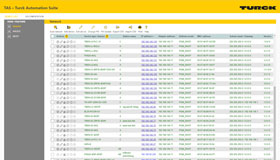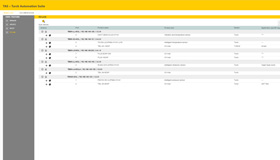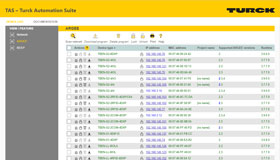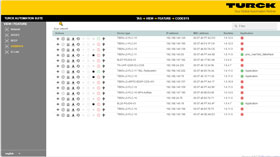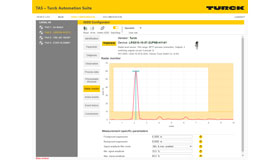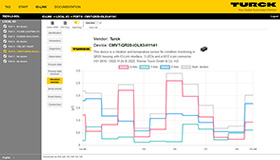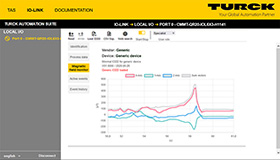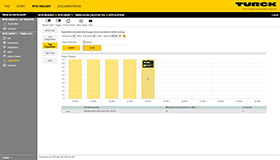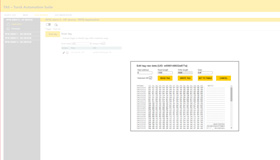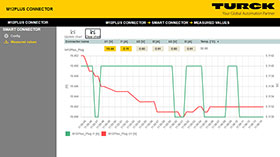TAS – IIoT Service Platform

Configuration and device management
TAS stands for Turck Automation Suite. The IIoT platform enables you to get everything from your Turck device and benefit from a complete solution for updates, device management and smart sensors. Future TAS versions will offer extensive IIoT functions for services such as condition monitoring or edge control on PCs or local servers.
Turck's TAS version V1 simplifies the management and commissioning of Turck devices in Industrial Ethernet networks as well as ARGEE and BEEP applications. The IIoT platform TAS also enables you to carry out thorough feasibility studies for RFID systems.
Network View simplifies device configuration
TAS enables you to manage all Turck devices in your production network. The Network scan function finds all available Turck Ethernet devices in the network and displays the relevant device information directly. Network View also enables the issuing of IP addresses and passwords as well as the execution of firmware updates for all devices in the network. The device specific web pages of all Ethernet devices can be accessed directly from TAS. Similarly, IO-Link configurations can be imported and exported via this view.
IO-Link View
This view provides an overview over IO-Link masters in the network as well as connected IO-Link devices
- Read device information
- Execute device actions like wink, open master in TAS, open IODD configurator, open device monitor
- Filtered view on selected IO-Link devices

Batch functions for rapid commissioning
Many of the Network View functions can also be performed as batch functions. This allows many devices to be updated and processed at the same time, thus saving a lot of time when commissioning and maintaining large networks – and all this without a PLC or a third-party software. The ability to export device networks in CSV format also simplifies documentation, collaboration and management. Batch importing of IO-Link configurations is also possible.
ARGEE View
The ARGEE logic software turns Turck's Ethernet I/O modules into IP67 logic controllers for use directly in the field (Field Logic Controller). This function is unique on the market to date. TAS allows you to load ARGEE programs conveniently on a group of devices in a batch process and manage them centrally.
Codesys View
Codesys View can be used to display almost all Turck controllers with Codesys in the network (in future also for TX devices). The control programmes of the connected devices can be downloaded and saved. Users can also run or stop the programmes via TAS in cold or warm start. The import of programmes on several Turck controllers (restore) also works in batches, which can speed up work with several instances enormously. Codesys user names and passwords can also be used via TAS.
BEEP View
Turck's Backplane Ethernet Extension Protocol “BEEP” helps you to reduce the number of IP addresses required in your industrial network. Up to 32 Turck IO devices can be accessed via the IP address of a BEEP master. TAS manages the configuration of BEEP networks as well as the import and export of BEEP configurations centrally and clearly.
IO-Link apps: using smart sensor functions
Applications (Apps) are TAS functions on the device level that can be run very easily with plug and play without any additional installation required.
IODD Configurator
IO-Link devices of all manufacturers can be parameterized via the IODD Configurator, which produces a graphical plot display of the IO-Link process data.
Radar Monitor: real-time data visualization for radar sensors
The Radar Monitor provides a graphical display of Turck Radar sensor data. Users can adjust filters, measuring windows and other parameters very easily to their particular application requirements. It enables comprehensive condition monitoring and increases machine availability, detects faults at an early stage and prevents costly damage and downtime.
Vibration Monitor: Proactive maintenance with CMVT sensors
The CMVT vibration and temperature sensor optimizes maintenance intervals, warns of critical vibrations, detects problematic machine conditions and measures the temperature. In conjunction with the vibration monitor, it increases machine availability, prevents costly damage and facilitates integration into existing systems.
Magnetic Field Monitor
This app graphically displays the data of Turck's IO-Link magnetic field detectors and thus facilitates their configuration.
Introduction Video: Turck Automation Suite (TAS)
RFID apps: UHF demo tools
The IIoT platform provides three UHF demo tools specially for RFID devices in TAS:
- Gate Applications simulates the bulk detection of tags in gate applications. The app checks whether all tags have been detected with sufficient certainty. Anyone who has ever had to assess a bulk detection operation manually knows how much time and effort this saves.
- Tag Trace enables users to determine the ideal start and stop times for optimum read and write processes in moving applications.
- Tag Population reads the read and write performance at different tag positions of a static object. For this, the UHF reader continuously increases its power and indicates the minimum power required to reliably read the tag.
RFID apps: HF Tag Actions
Various functions are available in the HF frequency band to help with system maintenance or the design of an RFID system.
- Scan UID of HF data carriers and create a list.
- Read tag metadata: Type, memory size and supported features of a data carrier
- Read tag memory (hexadecimal, ASCII)
- Write data to selected memory areas
HF Tag Actions
- HF Quality now displays the quality of the transmission and the strength of the RSSI value for Turck's Ethernet read/write heads such as the Q130. This provides more transparency and security when commissioning HF RFID systems.
- HF Tune Antenna indicates the potential detuning of HF read/write heads for long ranges (TNSLR). This can be caused by metallic environments. Based on the analysis, users can take and check measures to ensure read/write performance even over long ranges.
Cable Monitor
The Cable Monitor app displays the voltage and current of the M12Plus connectors. This allows fluctuations in current or voltage drops to be recognised at an early stage. The temperature of the connectors is also displayed, which can provide an indication of defects.
Select Country
Turck worldwide


